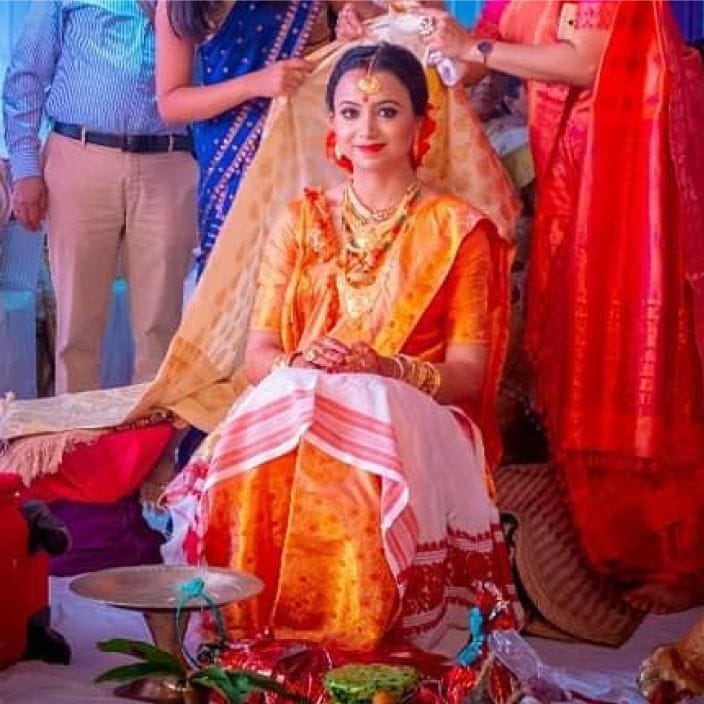For best prices and early deliveries, WhatsApp us at. 918488070070

Juran Diya
Weddings in Assam have a series of pre-wedding rituals before the big day. Taking place a day or two before the wedding, Juran Diya starts the wedding festivities. On the morning of the ceremony, the families attach strings of mango leaves, called Aaam dali gatha, to the doors of their homes. This is believed to absorb negative energies from anyone entering the home and set a positive note for the ceremony. For the ceremony, the groom’s mother visits the bride’s home to perform some traditional rituals along with other women from her family. They come bearing gifts of clothes, jewellery, and sweets for the bride and her family. The more traditional gifts include Xorai, a bell metal plate with Pan and Tamul, betel leaves and nuts, and Gamusa, an Assamese white silk cloth decorated with red thread embroidery and motifs. These are symbols of goodwill, love, and respect and are meant to welcome the bride to her new family. The bride covers her head with a dupatta out of modesty and respect for her soon-to-be mother-in-law and asks for her blessings. Throughout the ceremony, the women chant hymns, sing folk songs, and pray to their gods for a smooth wedding.
Cultural Significance
The Juran Diya is an age-old ceremony in Assamese culture. It works both as a formal acceptance of the wedding by the two families as well as a show of welcoming the bride. Only after this ritual can the rest of the wedding ceremonies proceed.
At its core, this event incorporates the values of respect and hospitality integral to Assam weddings. The groom’s mother offers thoughtful and culturally significant gifts to the bride and her family, and the bride, in turn, shows her respect for her. This sets the right tone for the wedding and will hopefully carry forward into the marriage.
Fashioning Tradition
Typically, the bride wears a traditional Mekhela Chador for the Juran Diya ceremony. Similar in look to a saree, it is a two-piece ensemble made of a pleated skirt, the Mekhela, and a draped upper garment, Chador. The bride can wear it with a Rihu cloth tied on her chest or a stitched blouse. The ensemble is often made from an Assamese silk such as Muga, Pat, or Eri and embroidered with gold and silver zari. White and gold are classic colour combinations for the Mekhela Chador, but shades of red, pink, green, yellow, and blue are also popular.
Assam is famous for its silk industry, and the region of Sualkuchi is known as the ‘The Silk Heaven of India’. The most coveted silk of the state is Muga silk, followed by Pat silk and Eri silk or Ahimsa silk. Apart from the Mekhela Chador, the bride can also wear a Muga silk saree, Pat silk Saree, or Eri silk saree. These sarees have a rich quality and natural sheen that are perfect for the bridal trousseau. They are also often embroidered with floral, geometric, and Gamosa motifs.
Jewellery & Accessories
The Assamese bride loves her gold jewellery. We are talking layers of gold necklaces, thick bangles, and beautiful earrings. What sets her look apart from other Indian bride are certain stunning pieces unique to Assam.
Dholbri is a long necklace with a beaded silk chain and a drum-shaped pendant. Featuring meenakari work and gems, the pendant is the standout element here. She can pair this with a Golpata, an Assamese choker necklace made from gold and studded with colourful stones. It has dainty floral designs that complement every bride’s ensemble.
Image Credits
Wedding Wire | Cultural India | Alamy | Wikipedia | Bollywood Shaadiz | Pinaxis | Madhumita's Blog-Room